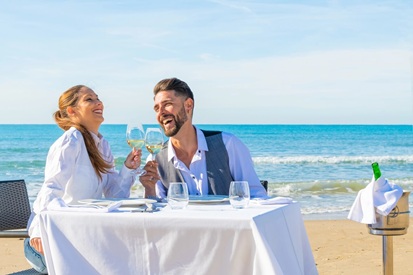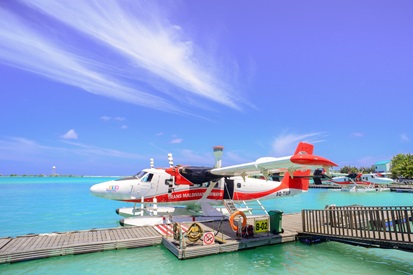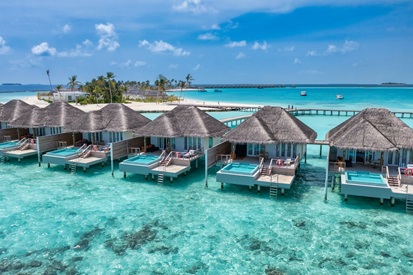

How and where to exchange currency on the paradise islands, withdraw money from an ATM and when dollars are enough for a holiday in the Maldives - learn about all the financial intricacies of the trip.
Maldivian banknotes are some of the most colorful and vibrant in the world. It is worth exchanging the currency for local currency just to hold them in your hands and admire the beautiful pictures. True, it is forbidden to take such currency with you as a souvenir, but local banknotes will help you save money if you are vacationing on a local island in the Maldives.

Depositphotos
A little history about Maldivian money
The Maldives' own currency appeared not so long ago - in 1947. Before that, British pounds, Indian rupees and even cowries - sea shells - were in circulation here. The name "rufiyaa" comes from India, as does the idea of the monetary system itself: the Maldives have always been closely connected with their neighbor. Even the name "rufiyaa" comes from the Sanskrit word rupya, which means "processed silver".
In the 1960s, after gaining independence, the country began to actively develop its currency. In 1981, the Maldives Monetary Authority was created - it is responsible for the issuance and control of money. At first, rufiyaa were printed on ordinary paper. Later, more secure banknotes appeared, and in 2015, a new series was released - completely plastic. Such banknotes are not affected by Maldivian humidity and tropical rains.
.jpg)
Depositphotos
Exchange rate to dollar and euro
The Maldivian rufiyaa is designated as MVR or Rf. You will most likely come across notes in denominations from 5 to 1000 rufiyaa: these are the most common. One US dollar is approximately equal to 15.46 rufiyaa (the rate may fluctuate slightly). In general, the rufiyaa remains a stable currency, pegged to the US dollar. The euro to rufiyaa exchange rate is 17.4.
.jpg)
Depositphotos
What does Maldivian money look like?
The Maldivian Rufiyaa is very colourful: the plastic banknotes depict scenes from the life of the Maldives: fishermen, sea animals, traditional crafts, dhoni boats, scuba diving:
- Rf 5 - turquoise banknote, depicting a fisherman with a net
- Rf 10 - pink, traditional dance shown
- Rf 20 - purple, with a picture of a boat
- Rf 50 - blue, with sea turtle
- Rf 100 - green, with dolphins
- Rf 500 - red, diver depicted
- Rf 1000 - grey, with coral reef
The reverse side features local landscapes, architecture and symbols. The coins are rarer and are usually used only on local islands.
.jpg)
Depositphotos
Currency exchange in the Maldives
So, if you are going to a local island, you need to exchange dollars for rufiyaa. In this case, it is more convenient to immediately upon arrival change a small amount to pay for expenses in stores, markets, and ferries.
- You can exchange money in the Maldives only upon arrival - the national currency of the Maldives cannot be purchased outside the country.
- There are exchange offices at Velana International Airport, in exchange offices in Malé and Hulhumalé.
- It is best to exchange money in banks in the capital - the rate there is usually more favorable than at resorts. Banks are open from 8:00 to 13:00, Friday is a day off.
- You can also exchange currency in hotels and resorts, but the rate is usually less favorable. And there is nowhere to spend it - unless you are planning a trip to a traditional village or to the capital Malé for souvenirs.
Important: when exchanging rufiyaa, be sure to keep the receipt. Without a receipt, the bank may refuse to exchange the remaining rufiyaa back for dollars or euros. Also, without a document, it will not be possible to prove the legality of the currency exchange. And on the way back at the airport, they can simply take them away, because export is prohibited. There are most exchange offices where you can exchange a dollar bill for a colorful Maldivian one in Malé:
- Inter Ocean Currency Exchange (SP Villa, Roashanee Magu, Malé)
- MS Finance Currency Exchange (No. 29, Chaandhanee Magu, Malé)
- My Zone Tuck Shop (near MMA, Malé)
- Aksa Forex (Near Bombay Darbar, Hulhumalé)
.jpg)
Depositphotos
How to exchange money profitably in the Maldives
- Bring new dollar bills. Exchange offices do not accept bills of all years of issue (this is generally common in Asian countries). They may simply refuse to exchange, or offer an exchange with a large commission. Also, bring only whole bills, not wrinkled, not torn, not sealed.
- For small expenses, exchange a little for MVR. At the resort, you simply won't have anywhere to spend them.
- Check the rate at several exchangers.
- Do not exchange money in hand - you will not be given a receipt for the exchange.
Is it worth changing money upon arrival?
Depends on where you are flying: to a resort island or to relax on local islands. At a separate resort, you are unlikely to need Maldivian money. It is easy to pay by card and any currency. On local islands, you still need to have rufiyaa with you.
Currency innovations in the Maldives in 2025
Since 2025, new rules have been in effect in the Maldives regarding the circulation of currency in the country. Their essence is that all settlements are in rufiyaa. This is how the authorities are trying to replenish the currency reserve in the country. So now the use of rufiyaa is mandatory.
- All internal settlements - payment for goods, services, rent, salaries must be made in MVR. Exceptions are provided only for certain international transactions (exports and transfers of funds).
- Resorts must exchange either a minimum of $500 per tourist per month or 20% of their monthly foreign currency revenue into rufiyaa through licensed banks.
For tourists, these changes mean that in everyday situations, it is preferable to use Maldivian rufiyaa, for example, to pay for public transport.
ATMs in the Maldives and what bank cards are accepted
Most ATMs are located in Malé, but there are also some popular local islands, such as Maafushi. In Malé, you can easily find them at the airport upon arrival. If you are planning a trip to a small local island, study the information in advance to see if you can withdraw money there. If not, take cash right away. Among the islands where you will definitely not be left without "live" money:
- Hulhumalé - is located near Malé, it is a transit hub, so the island is full of ATMs.
- Addu City (Gan) - in the southern part of the Addu Islands. It is a large island, an economic hub that essentially unites three islands into one. There are ATMs in the Gan and Hithadhoo areas.
- Fuvahmulah - is an isolated island popular with divers, so they even installed an ATM there so tourists could pay for services.
- Maafushi - is the most popular island among budget travelers. There are several ATMs on Maafushi.
- Thulusdhoo - is another developed island, especially popular with surfers. There are several ATMs.
If you are staying at a resort, there may not be an ATM on site, so it is best to withdraw cash while in Malé or on a local island where there are banking facilities.
How to profitably withdraw money from an ATM
Maldivian ATMs usually dispense MVR. However, some ATMs, such as those at the airport or in Malé, may dispense US dollars. Look for Bank of Maldives ATMs at the airport or in Malé. However, given the currency restrictions that have been in place since 2025, the ATM may not have dollars. There will also be a fee for withdrawing dollars.
International cards usually incur a fee for withdrawals - up to 10%, depending on the bank and currency. Your bank may charge an additional fee. Be sure to check with your bank what the interest rate will be for ATM withdrawals before you travel.
Limits: ATMs often limit the amount of a single transaction (usually 10,000-15,000 MVR).
Bank cards
Visa and Mastercard are accepted in most hotels, dive centers and expensive restaurants. Less often on local islands. American Express and other exotic cards work inconsistently, it is better to check with the hotel in advance when booking. Shops and cafes on local islands often take only cash.
- In the Maldives, when paying by card, you may be in for a surprise - an additional fee. For example, if you pay a guest house tax by card (and this tax usually cannot be paid when booking), you will be charged an additional 3%. In general, additional taxes and fees for tourists are common in the Maldives, so stock up on cash and patience.
- In some places, card payments are only possible for amounts of 100 MVR or more.
- Most often, the amount withdrawn from the card is in dollars. Conversion rates in most banks are unfavorable, plus a commission of 2-5%.
- Sometimes DCC (dynamic conversion) is automatically enabled - and this makes the purchase more expensive. That is, you pay twice for currency conversion.
- Another option is cards like Revolut, Wise. They may offer low fees when paying or withdrawing, as you can convert the currency on the card into rufiyaa.

Depositphotos
International and bank transfers
In the Maldives, there are no problems with receiving money via Western Union and MoneyGram. On developed islands, for example, in Malé and Hulhumalé, you will find offices where you can receive a transfer in dollars or Maldivian rufiyaa.
How to receive a transfer:
- Find your nearest Western Union or MoneyGram location.
- Please take your ID and transfer number.
- The transfer can be received in cash in the transfer currency or in rufiyaa at the current exchange rate.
- Commissions: depend on the amount and place of transfer, usually 3-10% of the amount.
Bank transfer
You can receive a transfer through a bank using international SWIFT transfers. This method is suitable if the sender uses your bank account, not a cash desk. This service is available at major banks such as Bank of Maldives. You will have to pay a fee of 5% to 10% depending on the bank and the amount transferred.
- Provide the sender with your bank details: account number, bank SWIFT code and other information.
- The transfer may take from 1 to 5 business days, depending on the bank.
- Banks may charge a fee for processing the transfer.
.jpg)
Depositphotos
How much money to take with you to the Maldives
- If you are going to an island resort on a package tour, where transfers and meals are already paid for, focus on the amounts on the restaurant menu, the cost of excursions and souvenirs.
- If meals at the resort are paid separately, take at least $1,000. For active excursions and SPA - about $3,000 per person. But the prices also depend on the resort - the more elite the hotel, the more expensive the entire vacation in it.
- The hotel may place a hold on your account to cover additional services. This amount can range from $800 to $2,000.
- Tipping: Although the local government does not encourage tipping, it is left for good work. Tipping is usually 10-12% of the bill (it may already be included in the final bill). It can be left in any currency. Small dollars or rufiyaa are the best option.
- Meals on local islands. Expect to pay around $10 per meal. Don't forget about taxes. They will need to be paid in dollars. A local ferry ride will cost between $1-5. Check the cost of excursions on the islands you are going to. Prices may vary.
.jpg)
Depositphotos
How much money can you bring to the Maldives
Restrictions on the import of currency apply only to Maldivian rufiyaa. Foreign currency can be carried without restrictions. But do not forget about the rules for exporting currency from your country - as a rule, the amount should not exceed the equivalent of 10,000 dollars. That is, if you brought a large amount with you, you need to declare it so as not to have problems when leaving if you did not spend everything.

Depositphotos
Conclusions
- If you are flying to a resort, you don't have to worry. Both your card and contactless payment by phone will work there. It might be worth changing some money for souvenirs.
- To travel to local islands, you need to take dollars with you. This is the most profitable option. But only take whole and not very old bills. You can exchange them for rufiyaa at the airport, bank or exchange offices. Do not forget to keep the receipt.
- You can withdraw rufiyaa or dollars from an ATM - but with a commission. Paying by card is not always profitable, and is not possible on all islands. And on remote islands without infrastructure, you can be left without money if you do not stock up on cash, since there will be no ATMs there. In case of financial problems, for all transfers go only to Malé.
Take some cash (dollars, euros), a good multicurrency card and a regular Visa or Mastercard just in case. You can find the best holiday option in the Maldives on WIOTTO. A wide selection of hotels is available in the catalogue.

Depositphotos
More articles
- Rains in Bali: pros and cons of the wet season
- Hotels of Ayana complex in Bali
- Gunung Batur: how to get to the main volcano in Bali
- Likupang on Sulawesi Island in Indonesia
- Mauritius Attractions: 27 Best Places to Visit
- Bali for Two: 24 Romantic Getaway Ideas
- Top 20 Bali Tours: Itineraries, Offers, and Prices
- Bali's Best Beach Clubs - 13 Luxury Oases
- Tips for tourists in Indonesia - how to avoid spoiled holidays
- Yoga Studios in Bali - where to catch Zen on the Island of the Gods



